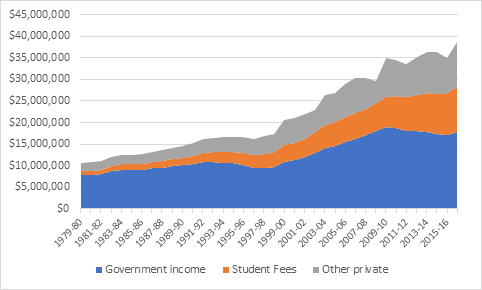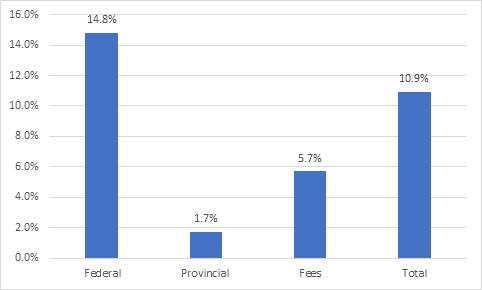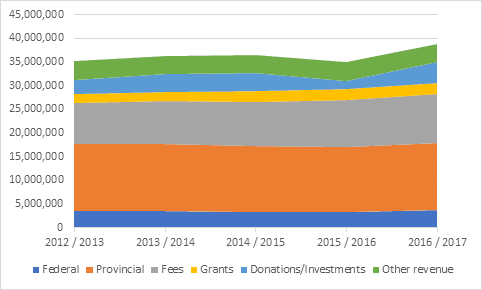CANADIAN UNIVERSITY FINANCES 2016-17 (INCOME)
| ALEX USHER
So, the 2016-2017 Financial Information of Universities and Colleges came out in July, and as usual I’ve got some highlights for you. This year, we’ll be doing this as a two-parter, one on income (today) and one on expenditure (tomorrow). For those of you looking for data on community college expenditures, I’m afraid you’ll have to wait a few months – Statscan typically doesn’t release that data until December (but rest assured I will cover it when the time comes).
Figure 1 shows the big, long-term picture. University income, in real dollars, is still on an enormous long-term up-tick. This year, total income was $38.7 billion. That’s a 139% increase in real dollars (i.e. accounting for inflation) in the past 20 years.
Figure 1: University Income by Source, Canada, 1979-80 to 2016-17, in constant $2016

The big change over the past decade, as I’ve noted several times in the past, has been the flat-lining over government support and the increase in income from student fees. Now, what’s interesting here is that the increase in student contributions hasn’t come about through huge increases in domestic tuition fees. Base tuition has been rising at about inflation +1.5%, but tuition income has been rising at inflation +5%, which has essentially made up for any loss of government income plus a little bit more. The gap, of course, is accounted for entirely by increasing international student enrolment.
Now let’s focus in a little bit more detail on just this last year, because there is some pretty wild stuff going on.
Figure 2: Real Change in Income by Source, Canadian Universities, 2015-16 to 2016-17

If you just look at the topline data, 2016/2017 looks like an insanely good year – total income was up over 11% after inflation over 2015-16! And sure, some of it was international student fees but whoa mama look at that federal number! Must be all that granting council cash from the 2016 budget! Good times!
Well….yes and no. The spike in federal cash actually has nothing to do with granting council income, which actually fell slightly in 2016. Rather, this all appears to be infrastructure money, which is good and all but doesn’t increase operational budgets. And the big jump this year over last mostly has to do with 2016-2017 being an exceptionally good year for endowment returns ($2.1 billion in total) and 2015-2016 having been an exceptionally bad one ($61 million).
If instead you look at the data over five years, what stands out is the stability, not the volatility.
Figure 3: Income by Source, Canadian Universities, 2012-13 to 2016-2017, in real $2016

Perhaps more to the point, if you look at divide up last year’s windfall into “stuff institutions can spend now” and “buildings and endowments”, about 75% of last year’s windfall went to the latter. That’s good news for the future, but not a big impact for the present day. Still, an increase in core funding (fees plus provincial grants) of inflation plus 3% or so should be considered a good year in anyone’s books.
The usual suspects will of course probably still keep gabbing about “austerity” because zombie rhetorical constructs can never die. But we’ll know better – right
0 Comments